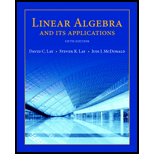
Concept explainers
Let v be the center of mass of a system of point masses located at v1, …, vk as in Exercise 29. Is v in Span {v1, …, vk}? Explain.
29. Let v1, … vk be points in ℝ3 and suppose that for j = 1, … , k an object with mass mj is located at point vj. Physicists call such objects point masses. The total mass of the system of point masses is
m = m1 + … + mk
The center of gravity (or center of mass) of the system is
Want to see the full answer?
Check out a sample textbook solution
Chapter 1 Solutions
Linear Algebra and Its Applications (5th Edition)
- Solve the equation. Write the smaller answer first. 2 (x-6)² = 36 x = Α x = Previous Page Next Pagearrow_forwardWrite a quadratic equation in factored form that has solutions of x = 2 and x = = -3/5 ○ a) (x-2)(5x + 3) = 0 ○ b) (x + 2)(3x-5) = 0 O c) (x + 2)(5x -3) = 0 ○ d) (x-2)(3x + 5) = 0arrow_forwardA vacant lot is being converted into a community garden. The garden and a walkway around its perimeter have an area of 690 square feet. Find the width of the walkway (x) if the garden measures 14 feet wide by 18 feet long. Write answer to 2 decimal places. (Write the number without units). Hint: add 2x to each of the garden dimensions of 14 x 18 feet to get the total area for the length multiplied by width.arrow_forward
- Solve the rational equation 14 1 + x-6 x x-7 x-7 ○ a) x = 1, x = 8 ○ b) x = 1 ○ c) x = 7 ○ d) x = 1, x = 7arrow_forwardSolve the absolute inequality | x + 5 > 3 ○ a) (-∞, -8] U[-2, ∞0) ☐ b) (-8, -2) c) (-2, ∞0) ○ d) (-∞, - 8) U(-2, ∞0)arrow_forward1) Listen Describe the error in the problem X 3 X x 3 - 2 = 25x = 0 25x 25 x = ±5arrow_forward
- A falling object travels a distance given by the formula d = 6t + 7t² where d is in feet and t is the time in seconds. How many seconds will it take for the object to travel 115 feet? Round answer to 2 decimal places. (Write the number, not the units). Your Answer:arrow_forwardListen Solve the quadratic equation. Write the smaller answer first. 2 Xx - 5x = 24 x = Α x =arrow_forwardSolve the absolute equation |2x = 4| = 10 ○ a) x = -7, x = 3 ○ b) x = -2, x = 6 ○ c) x = -3, x = 7 ○ d) x = 7arrow_forward
- Algebra & Trigonometry with Analytic GeometryAlgebraISBN:9781133382119Author:SwokowskiPublisher:Cengage
 Elementary Geometry For College Students, 7eGeometryISBN:9781337614085Author:Alexander, Daniel C.; Koeberlein, Geralyn M.Publisher:Cengage,
Elementary Geometry For College Students, 7eGeometryISBN:9781337614085Author:Alexander, Daniel C.; Koeberlein, Geralyn M.Publisher:Cengage,

